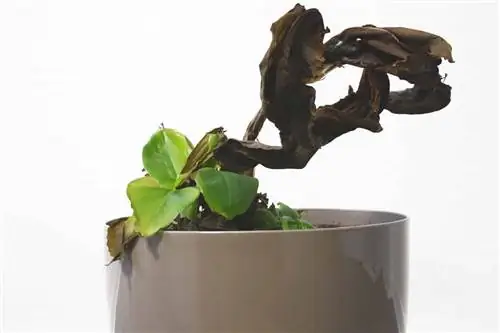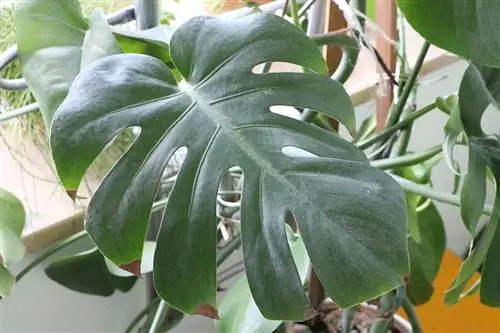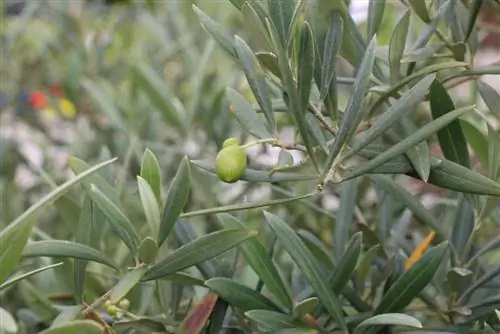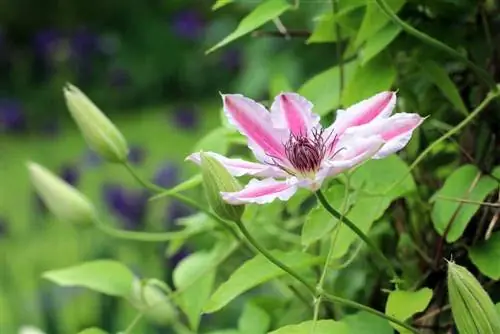- Author admin [email protected].
- Public 2023-12-17 03:39.
- Last modified 2025-06-01 06:48.
Banana plants grow very quickly, with some indoor or garden specimens growing up to 3.5 meters high. The attractive plants are a real eye-catcher, but require correct care. Brown leaves, for example, are usually a clear indication of care errors that must be remedied immediately - otherwise there is a risk of death of the sensitive potted plant.
When to act
If the leaves of the banana plant turn brown or develop brown spots, this is not always an alarm sign. Like the cells in the human body, Musa - the botanical name for the plant genus comprising around 70 species - regularly renews individual leaf parts. Older leaves die off and make way for new shoots. As long as this phenomenon is limited to individual leaves or parts of leaves, only occurs occasionally and does not spread, you have nothing to worry about. This is especially true if only some of the older leaf tips and/or the edges of the leaves turn brown. Simply cut off the affected leaves and keep a close eye on the new growth: the young shoots should not develop any brown spots.
Brown leaves through training children
Banana plants reproduce through the formation of so-called children, which are practically daughter plants that are genetically identical to the mother plant. These sprout from the soil around the trunk of the mother plant. The offshoots mainly occur in older specimens and rob the mother of nutrients and moisture. As a result, it develops brown leaf discoloration due to the deficiency.
This is what you can do now:
- Remove children from four to six leaves
- Carefully dig up the cuttings and pull them out of the planter together with the roots
- do not damage any roots if possible
- Then place young plants in separate pots
- cut off brown leaves on the mother plant
- provide these with an extra portion of fertilizer
Tip:
Like every living thing, the banana is not immortal. If older plants suddenly produce a noticeably large number of children, this is sometimes an indication that they are about to die. Remove the children and care for them separately in order to have offspring available if the worst comes to the worst.
These care mistakes lead to brown leaves
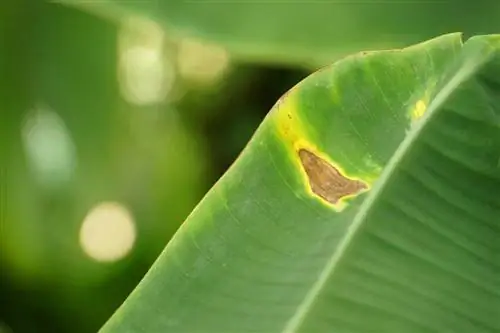
However, if the brown spots spread over a large area on one or more leaves, there is often something else wrong with your banana plant. As a rule, care errors cause leaf discoloration, which in turn can lead to secondary diseases or pest infestations. After all, the banana shows that she is not feeling well, that she is weakened - and therefore more susceptible to secondary illnesses.
Tip:
When banana leaves turn brown, many a hobby gardener is tempted to immediately reach for the watering can. Resist this temptation, as lack of water is just one of the many possible causes. Instead, it is important to carefully find out the specific reason and remedy it as quickly as possible.
Lack of water / waterlogging
Increased watering is actually not always the best solution, but what is much more important is the targeted supply of water to the banana. In addition to a lack of water, excess moisture can also lead to brown leaves - waterlogging is just as damaging as dryness.
Watering banana plants properly:
- Allow the surface of the substrate to dry between two waterings
- Never allow the substrate to dry out completely
- Substrate should be moist but not wet after watering
- Ensure good drainage, e.g. B. through drainage at the bottom of the pot
- Remove excess water from the planter or saucer promptly
So that you know the right time to water, you should check the substrate daily. Some banana plants are also noticeably thirsty: these are often the older specimens with large leaves. As a rule of thumb, the larger the leaves of the banana plant, the more water it needs. This is mainly due to the high evaporation rate, because large leaves naturally release more water into the environment. Always water bananas with soft rainwater or well-stale tap water, which is ideally at room temperature.
Tip:
Repot the banana in fresh substrate every one to two years, because over time its water storage capacity decreases significantly. This also ensures that the moisture is passed on unevenly and the water flows through faster than the roots can absorb it.
Low humidity
As classic rainforest plants, bananas depend on high air humidity, which, however, is not the case, especially during the heating period in the winter months. On average, the humidity in heated rooms is between 20 and 30 percent - far too low for banana plants, which need at least 50 percent, preferably more.
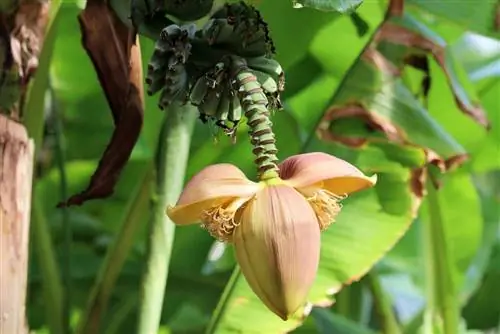
Dry air occurs mainly in winter
If the moisture content in the heated apartment is too low, even increased watering will not help. Quite the opposite: increased watering of the substrate not only leads to even more moisture evaporating through the leaves - it also very easily causes waterlogging, which in turn leads to root rot and thus the death of the plant.
Increase humidity
Instead, increase the humidity around the banana plants by misting the leaves using a mister. To do this, use low-lime, soft water such as rainwater or well-stale tap water. Alternatively, simply place the banana in the bathtub and shower with a fine shower spray. This also has the advantage that dust is washed off the leaves and photosynthesis is improved.
Lack of light / sunburn
Banana plants need a lot of light for optimal growth and he alth. However, a place in the blazing sun is not necessarily important, as this can also lead to leaf discoloration - this is especially true if Musa is moved from the living room to the sunny balcony in the summer without any preparation.
The right location for the banana plant:
- bright and sunny
- best directly behind a south-facing window
- Bright sun generally not a problem
- but: sudden change of location causes sunburn
- that's why plants get used to it gradually
Especially in the winter months, the light intensity can be far too low or too short for the banana, which is why installing a plant lamp is a sensible investment.
Tip:
A thick layer of dust on the leaves can also lead to brown leaves due to lack of light, which is why you should rinse the banana at regular intervals.
Nutrient Deficiency
Banana plants are heavy feeders and therefore rely on a regular and balanced supply of nutrients. But be careful: a lot doesn't help much in this case either, because over-fertilization is just as harmful as over-supply.
How to properly fertilize the banana plant:
- repot into fresh substrate every one to two years in spring
- use palm soil for this
- Start fertilizing six to eight weeks after repotting
- Use liquid fertilizer for palm trees
- Fertilizer sticks or other long-term fertilizers are also suitable
- Frequency: once a week between April to September, once a month between October and March
Tip:
During the winter months, banana plants take a break from vegetation, during which they should be kept a little cooler and watered and fertilized more sparingly.
Pest Infestation

Spider mites in particular - also known as red spiders - as well as mealybugs and scale insects often cause problems for the banana plant. An infestation with these pests leads to discoloration and death of the banana leaves, which is why you should regularly check the plant for unwelcome guests, especially on the undersides of the leaves. By the way, such a pest infestation is always an indication that the air is too dry, as spider mites in particular prefer dry and warm locations.
How to Treat a Pest Infestation:
- Keep humidity constantly high by spraying
- If the infestation is small, shower the banana regularly
- Wipe mealybugs with a damp cloth
- use neem-based insecticides in stubborn cases
- cut off discolored leaves
Tip:
Simple baby wipes have proven useful for wiping leaves infested with mealybugs and mealybugs. However, under no circumstances should you use cloths containing oil, as these are not tolerated by the banana leaves, which are sensitive to this.

